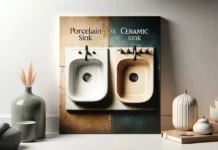Selecting the best shower flooring is an important decision during bathroom renovation. Among the available options, pebble shower floors are popular for their natural look and safety benefits. This guide will help you know the advantages and potential drawbacks of incorporating pebble tiles into your shower space, providing valuable insights to help you make the best choice for your bathroom upgrade.
Pros and Cons of Pebble Shower Floors
Pebble shower floors offer many benefits that add to their increasing popularity in modern bathroom design:
Durability and Longevity
Pebble tiles are durable and resilient. They can withstand the daily wear and tear that a bathroom floor experiences, ensuring your investment stands the test of time.
Beautiful and Natural Look
Pebble shower floors add a touch of nature indoors, inducing a spa-like atmosphere. Its natural, organic look complements various design styles.
Augmented Grip
The irregular surface of pebble tiles provides excellent traction. This textured surface offers the best non-slip surface, especially when the floor is wet.
Massage-like Effect
Walking on pebble tiles can stimulate acupressure points on the feet, providing a therapeutic and relaxing experience to many. It’s a kind of gentle foot massage.
Customization Options
Pebble tiles come in versatile colors, shapes, and sizes. This resourcefulness allows for creative patterns and designs that can be tailored to your specific preferences and style.
Easy Drainage
The natural gaps between pebbles facilitate effective water drainage, thus preventing water pooling and promoting a drier and safer shower area.
Possible Drawbacks of Pebble Shower Floors
While pebble shower floors offer numerous advantages, as elaborated above, it’s important to consider its potential drawbacks:
Uneven Rough Surface
Some individuals may find the uneven surface of pebble tiles less comfortable to stand on for extended periods, particularly the elderly and those with sensitive feet.
Grout Maintenance
The irregular shape of pebble tiles can make grout lines more difficult to clean. This might necessitate extra care over time to ensure a nice, clean appearance.
Cost Considerations
Pebble tiles, particularly high-quality types, have a higher price compared to the other available shower floor options. It’s important to consider this in your budget.
Installation Complexity
Installing pebble tiles requires a skilled worker and takes a longer installation time compared to laying down conventional tiles.
Addressing Common Concerns with Pebble Shower Floors
To address potential concerns associated with pebble shower floors, consider the following solutions:
A. Grout Sealing:
Penetrating/Impregnating Sealers:
Penetrating sealers, or impregnating sealers, are absorbed by the grout, forming a protective barrier. They help repel water, oils, and stains while allowing the grout to breathe. Silicone, fluorochemical, and siloxane-based sealers are some of the most common examples of penetrating sealers used.
Natural Look Sealers:
These sealers are designed to protect without altering the appearance of the grout. They maintain the natural color and texture of the grout while offering stain resistance.
Enhancing Sealers:
Enhancing sealers darken and enrich the color of the grout, giving it a slightly wet or “enhanced” look. They provide a subtle enhancement while still offering protection.
Color Sealing:
Color sealers are pigmented sealers that allow you to change or refresh the color of the grout. This option is useful for reviving faded or discolored grout lines.
Epoxy Grout Sealers:
Epoxy-based sealers are highly durable and provide exceptional protection against water and stains. They are ideal for shower spaces.
Water-Based Sealers:
Water-based sealers are easy to apply and clean up with water. They provide a clear, protective coating that repels water and stains.
Solvent-Based Sealers:
Solvent-based sealers offer excellent protection and are more resistant to harsh chemicals. However, they require proper ventilation during application.
Grout Additives:
Some sealers can be mixed with grout additives to enhance their effectiveness. These additives can improve stain resistance, color retention, and overall durability.
Professional Application:
For optimal results, especially with complex or large-scale projects, consider hiring an experienced professional to apply the sealer.
Use a high-quality sealant:
Apply a high-quality sealant to the Pebble grout lines. This can help safeguard against staining and simplify the cleaning process, alleviating maintenance concerns.
B. Comfort Solutions:
When it comes to addressing potential comfort concerns associated with pebble shower floors, there are various solutions to consider:
• Incorporate teak wood inserts into the pebble shower floor. The smooth, warm surface of teak wood complements the textured pebbles and provides a comfortable area for standing.
• Use foot-friendly grout sealants. They create a smoother surface on the grout lines, reducing any discomfort due to uneven grout.
• Place cushioned bathmats or pads over the pebble tiles. These add an extra layer of comfort and support for your feet.
• Install underfloor heating beneath the pebble shower floor. This not only provides a luxurious and comfortable surface to stand on but also keeps your feet warm, especially during winter.
• Use orthopedic insoles or supportive footwear designed for comfort. These can help alleviate any discomfort associated with standing on the pebble tiles.
• Include a built-in bench or seating area within the shower design. This allows you to comfortably sit while bathing or to take a break from standing on the pebble floor.
Conclusion:
Having mentioned pebble shower floor pros and cons, one can get a clear idea of the overall details. Pebble shower floors represent a compelling option for those seeking a unique blend of aesthetics and functionality in their bathroom. While they introduce a natural, spa-like ambiance and enhance safety, it’s important to weigh potential drawbacks like maintenance and installation complexity. By thoroughly understanding both the advantages and limitations, you can make a well-informed decision that aligns with your preferences and lifestyle.












